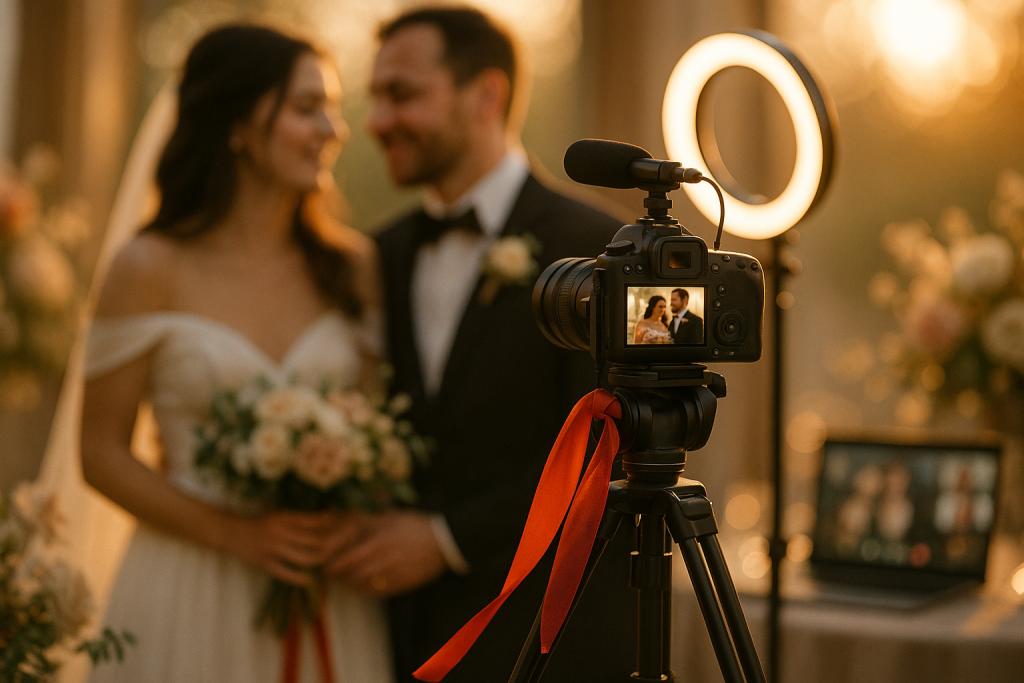Planning a virtual wedding brings unique opportunities to personalize your ceremony, especially when it comes to exchanging vows. One key decision is whether to write and read your own vows or to repeat traditional ones after your officiant. Let’s explore both options to help you decide which best suits your virtual wedding.
Understanding Virtual Wedding Vows
In a virtual wedding, vows can be delivered in various ways, each offering a distinct experience. The two primary methods are:
1. Reading Your Own Written Vows
Writing and reading your own vows allows you to express your feelings and commitments in a deeply personal manner. This approach can make your virtual ceremony more intimate and memorable. As noted by One Story Weddings, personal vows become a testament to your love story, ready to be revisited and cherished for years to come. Source
2. Repeating Traditional Vows After the Officiant
Opting for traditional vows, where the officiant reads a line and you repeat it, offers a sense of continuity and ease. This method can be particularly comforting if public speaking isn’t your forte. As highlighted by Young Hip & Married, this delivery style works best for traditional vows and in situations where the couple doesn’t want to speak very much during their ceremony. Source
Pros and Cons of Each Approach
Reading Your Own Written Vows
Pros:
- Personalization: Your vows reflect your unique relationship and promises.
- Memorability: Personalized vows can make your ceremony more memorable for you and your guests.
Cons:
- Public Speaking Anxiety: Reading personal vows can be daunting if you’re uncomfortable speaking in front of others.
- Time-Consuming: Crafting meaningful vows requires time and effort.
Repeating Traditional Vows
Pros:
- Simplicity: Less pressure to write and memorize vows.
- Tradition: Connects you to a long history of matrimonial commitments.
Cons:
- Lack of Personalization: May not fully capture your unique relationship.
- Less Engagement: Guests might find traditional vows less engaging.
Tips for Delivering Vows in a Virtual Setting
- Practice: Rehearse your vows to ensure smooth delivery during the ceremony.
- Technical Setup: Ensure your internet connection and audio equipment are reliable to avoid disruptions.
- Eye Contact: Look into the camera to create a sense of connection with your partner and guests.
FAQs
Q: Can we combine both methods in our virtual wedding?
A: Absolutely! Some couples choose to exchange personal vows privately before the ceremony and use traditional vows during the official event. This approach honors both personal expression and tradition. Source
Q: What if we’re too nervous to speak during the ceremony?
A: Consider having your officiant read your vows for you, or exchange written vows privately before or after the ceremony. This can alleviate anxiety while still making the moment special. Source
Q: How can we make traditional vows feel more personal?
A: You can modify traditional vows to include personal touches that reflect your unique relationship, blending tradition with personalization. Source
Q: Is it appropriate to use humor in our vows?
A: Yes, incorporating light humor can make your vows more engaging and reflect your personalities, as long as it remains respectful and appropriate for the occasion.
Q: How long should our vows be?
A: Aim for vows that are 1-2 minutes long to keep the ceremony engaging and meaningful without being too lengthy.
Conclusion
Choosing between written and spoken vows in your virtual wedding depends on your comfort level, personal preferences, and the tone you wish to set for your ceremony. Whether you opt for personalized vows or traditional ones, the most important aspect is that they resonate with you and your partner. For more guidance on planning your virtual wedding, feel free to contact us at Virtual Same Day Marriage.




